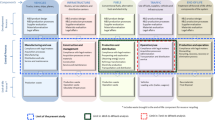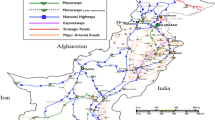Abstract
Purpose
A major task concerning the greening of freight transportation is to influence the process of choosing an appropriate transport solution for a shipment. This paper presents the results of a detailed environmental benchmark study of freight transport chains recorded during a shipper survey administered in Switzerland in 2008.
Materials and methods
For the environmental evaluation, life cycle assessment was applied and enhanced with a new method for integrating damage to human health caused by traffic accidents based on the disability adjusted life year concept.
Results and discussion
The results show that in land-based transport, road generally has a lower environmental performance compared to intermodal and rail-only transport. Exceptions exist, e.g. for long pre- and post-haulage distances in intermodal transport or for very low train-load factors. The most relevant environmental interventions to pay attention to are, according to the methods applied, emissions of CO2, NOx and particulates as well as accident damages.
Conclusions
Rail transport is often, but not always, environmentally preferable than truck transport. Accident damages to human health should be included in each benchmark study. For practical application, a simplified benchmark methodology is proposed requiring a reduced level of detail for the input data.

Similar content being viewed by others
References
Althaus HJ, de Haan P, Scholz R (2009) Traffic noise in LCA. Int J Life Cycle Assess 14(6):560–570
Barth M, Tadi R (1996) Emissions Comparison Between Truck and Rail: Case Study of California I-40; In Transportation Research Record: TRR 1520(1):44-52
Burgherr P, Hirschberg S (2008) Severe accident risks in fossil energy chains: a comparative analysis. Energy 33:538–553
Cucurachi S, Heijungs R, Ohlau K (2012) Towards a general framework for including noise impacts in LCA. Int J Life Cycle Assess 17(4):471–487
ETH Zurich (2009) IVT; PTV AG (eds) Spin-Alp Trainer. User’s Guide to the “Spin-Alp Planner” software; WP 5 of the EUREKA-project “SPIN-ALP”: Zurich, Switzerland
European Commission (2009) Directorate-General for Energy and Transport; Energy & Transport in Figures 2009
European Commission (2012) Directorate-General for Energy and Transport; EU energy in figures; Statistical pocketbook 2012; Publications Office of the European Union, Luxemburg
Facanha C, Horvath A (2006) Environmental assessment of freight transportation in the US. Int J Life Cycle Assess 11(4):229–239
Federal Office for Spatial Development (ARE) (2008) Federal Office for the Environment (BAFU) (eds) Externe Kosten des Verkehrs in der Schweiz. Aktualisierung für das Jahr 2005 mit Bandbreiten. Bern, Switzerland
Forkenbrock DJ (2001) Comparison of external costs of rail and truck freight transportation. Transp Res A Policy Pract 35(4):321–337
Fries N, de Jong G, Patterson Z, Weidmann U (2010) Shipper Willingness-to-Pay to Increase Environmental Performance in Freight Transportation. In Transportation Research Record: TRR 2168:33-42
Frischknecht R, Hofstetter P, Knoepfel I, Dones R, Zollinger E (1996) Ökoinventare für Energiesysteme. Grundlagen für den ökologischen Vergleich von Energiesystemen und den Einbezug von Energiesystemen in Ökobilanzen für die Schweiz. 3. Auflage, Gruppe Energie – Stoffe – Umwelt (ESU), ETH Zürich und Sektion Ganzheitliche Systemanalysen, Paul Scherrer Institut Villigen, Bundesamt für Energie (ed): Bern, Switzerland
Goedkoop M, Heijungs R, Huijbregts M, De Schryver A, Struijs J, van Zelm R (2009) ReCiPe 2008 – A life cycle impact assessment method which comprises harmonised category indicators at the midpoint and the endpoint level. Report I: Characterisation, 1st edition
Green Freight Europe (2013) How does Green Freight work? Green Freight Europe – The Programme; Retrieved on August 3, 2013 from http://www.greenfreighteurope.eu/the-programme/how-does-it-work.aspx
Guinée JB (ed) (2002) Handbook on Life Cycle Assessment. Kluwer, Dordrecht, The Netherlands
Hawkins T, Dente SMR (2010) Greenhouse gas emissions driven by the transportation of goods associated with French consumption. Environ Sci Technol 44:8656–8664
Hirschberg S, Burgherr P, Spiekerman G, Dones R (2004) Severe accidents in the energy sector: comparative perspective. J Hazard Mater 111:57–65
ICF (2009) Comparative Evaluation of Rail and Truck Fuel Efficiency on Competitive Corridors; Fairfax, VA, 2009. http://www.fra.dot.gov/Downloads/Comparative_Evaluation_Rail_Truck_Fuel_Efficiency.pdf
IFEU Heidelberg (2011) Öko-Institut, IVE / RMCON (ed) EcoTransIT World: Ecological Transport Information Tool for Worldwide Transports – Methodology and Data Update. Berlin, Hannover, Heidelberg, 2011; http://www.ecotransit.org
INFRAS (2007) Externe Kosten des Verkehrs in Deutschland. Aufdatierung 2005. Zurich, March 2007
INFRAS, IFEU, TU Graz, RWTÜV (eds) (2010) Handbuch Emissionsfaktoren des Strassenverkehrs 3.1 – Dokumentation. Bern/Heidelberg/Graz/Essen
Institut für Energie- und Umweltforschung Heidelberg GmbH (2003) Energy consumption and emissions of goods transports in Europe. Heidelberg, Germany
Jungbluth N, Frischknecht R (2004) Cumulative energy demand; In: R. Frischknecht and N. Jungbluth (Eds.); Implementation of Life Cycle Impact Assessment Methods. Ecoinvent report no. 3: Duebendorf, Switzerland
Maibach M, Peter D, Seiler B (1999) Ökoinventar Transporte: Grundlagen für den ökologischen Vergleich von Transportsystemen und den Einbezug von Transportsystemen in Ökobilanzen. Zurich, Switzerland, Technischer Schlussbericht, INFRAS
Murray CJL, Lopez AD (eds) (1996) The global burden of disease. Harvard University Press
Petterson J, Hertwich EG (2008) Occupational health impacts: offshore crane lifts in life cycle assessment. Int J Life Cycle Assess 13(5):440–449
Spielmann M, Bauer C, Dones R, Tuchschmid M (2007) Transport Services. ecoinvent report no. 14: Swiss Centre for Life Cycle Inventories, Dübendorf, Switzerland
Swiss Centre for Life Cycle Inventories (2013) ecoinvent database v 2.2, www.ecoinvent.ch
Swiss Federal Statistical Office (2013) Superweb; Swiss Statistics Data Library; Retrieved on January 20, 2013 from http://www.bfs.admin.ch/bfs/portal/de/index/infothek/onlinedb/superweb.html
Udo de Haes HA, Lindeijer E (2002) The conceptual structure of lifecycle impact assessment. In: de Haes HA U, Finnveden G, Goedkoop M, Hauschild M, Hertwich E, Hofstetter P, Klöppfer W, Krewitt W, Lindeijer E, Mueller-Wenk R, Olsen I, Pennington D, Potting J, Steen B (eds) Life-cycle impact assessment: striving towards best practise. SETAC, Pensacola
Vickery W (1968) Automobile accidents, tort law externalities, and insurance: an economist's critique. Law Contemp Probs 33:464–487
Wichser J (2010) System- und Netzplanung; chapter 5: Angebots- und Produktionssysteme im Güterverkehr; Lecture Notes, ETH Zurich – IVT: Zurich: http://www.ivt.ethz.ch/ivt/oev/publications/skripte
Acknowledgments
The work presented in this paper is part of a dissertation project, which was funded by and realised at ETH Zurich—IVT. The authors would like to thank Prof. Dr. U. Weidmann, chair for transportation systems, for his financial and scientific support of this project. Special thanks also to Christopher Mutel for his technical support and methodological help with the ecoinvent database, and to Michael Curran for his critical review.
Author information
Authors and Affiliations
Corresponding author
Additional information
Responsible editor: Rolf Frischknecht
Electronic supplementary material
Below is the link to the electronic supplementary material.
ESM 1
(PDF 322 kb)
Rights and permissions
About this article
Cite this article
Fries, N., Hellweg, S. LCA of land-based freight transportation: facilitating practical application and including accidents in LCIA. Int J Life Cycle Assess 19, 546–557 (2014). https://doi.org/10.1007/s11367-013-0657-2
Received:
Accepted:
Published:
Issue Date:
DOI: https://doi.org/10.1007/s11367-013-0657-2




